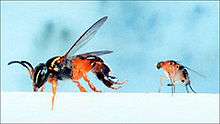Melaloncha
| Melaloncha | |
|---|---|
 | |
| Female Melaloncha punctifrons | |
| Scientific classification | |
| Kingdom: | Animalia |
| Phylum: | Arthropoda |
| Class: | Insecta |
| Order: | Diptera |
| Family: | Phoridae |
| Subfamily: | Metopininae |
| Genus: | Melaloncha Brues, 1904 |
| Type species | |
| Melaloncha pulchella Brues, 1904 | |
Melaloncha is a genus of phorid flies (Diptera: Phoridae) commonly referred to as "bee-killing flies". They are found almost exclusively in the Neotropical region, although there is one record from extreme southern Texas, United States.[1] They are small flies, usually about 2–3 millimetres (0.08–0.12 in) in length. No true fossils are known, although there are some specimens in Colombian copal, of unknown (but likely relatively recent) age.
Life history

Species of Melaloncha are parasitoids of bees, especially stingless bees (Meliponini), but also introduced European honey bees (Apis mellifera), bumblebees (Bombus), and halictid bees (Megalopta).[2][3][4][5][6][7][8] Some attack their hosts while flying, darting down to lay their eggs; others land, curl their ovipositor under their bodies and rush their hosts on foot (as in M. acoma, see photo); a few carefully land on their host and stealthily inject their egg.
The flies can be attracted by spraying a mixture of honey and water on undergrowth to attract an aggregation of host bees. Frequently, they are found on palm tree flowers (again, with host bees), and sometimes they are encountered around bee nests.
Taxonomy
The type species of the genus is Melaloncha pulchella Brues, a species from Bolivia. The holotype specimen was lost in a fire at the Hungarian National Museum. About 170 species are known, but many more exist, and the final total for the genus is likely to be 200–300.[9] Melaloncha is organized into two subgenera, Udamochiras (51 species) and Melaloncha (117 species).
Economic importance
The parasitization of honey bees and native stingless bees causes premature mortality of workers and is a drain on the colony. The effects of Melaloncha parasitism on commercial beekeeping, including efforts to keep native tropical stingless bees (meliponiculture), and the scale of financial losses due to these flies has not been studied.
References
- ↑ "Discover Life map of Melaloncha". Retrieved June 15, 2010.
- ↑ Brian V. Brown (2004). "Revision of the subgenus Udamochiras of Melaloncha bee-killing flies (Diptera: Phoridae: Metopininae)" (PDF). Zoological Journal of the Linnean Society. 140: 1–42. doi:10.1111/j.1096-3642.2004.00086.x.
- ↑ Brian V. Brown (2004). "Revision of the Melaloncha cingulata-group of bee-killing flies (Diptera: Phoridae)". Annals of the Entomological Society of America. 97: 386–392. doi:10.1603/0013-8746(2004)097[0386:ROTMCO]2.0.CO;2.
- ↑ Brian V. Brown & Giar-Ann Kung (2006). "Revision of the Melaloncha ungulata-group of bee-killing flies (Diptera: Phoridae)" (PDF). Contributions in Science. 507: 1–31.
- ↑ Brian V. Brown (2005). "Revision of the Melaloncha furcata-group of bee-killing flies (Diptera: Phoridae)" (PDF). Insect Systematics and Evolution. 36: 241–258. doi:10.1163/187631205788838384.
- ↑ Brian V. Brown (2006). "Revision of the untreated taxa of Melaloncha s. s. bee-killing flies (Diptera: Phoridae)" (abstract: PDF). Zootaxa. 1280: 1–68.
- ↑ Giar-Ann Kung (2008). "Two new species of the Melaloncha ungulata group of bee-killing flies". Sociobiology. 51: 491–496.
- ↑ Brian V. Brown (2009). "Three new species of parasitoid Phoridae (Diptera) from the Neotropical Region" (PDF). Sociobiology. 54: 715–722.
- ↑ Lisa Gonzalez & Brian V. Brown (2004). "New species and records of Melaloncha (Udamochiras) bee-killing flies (Diptera: Phoridae)" (PDF). Zootaxa. 730: 1–14.